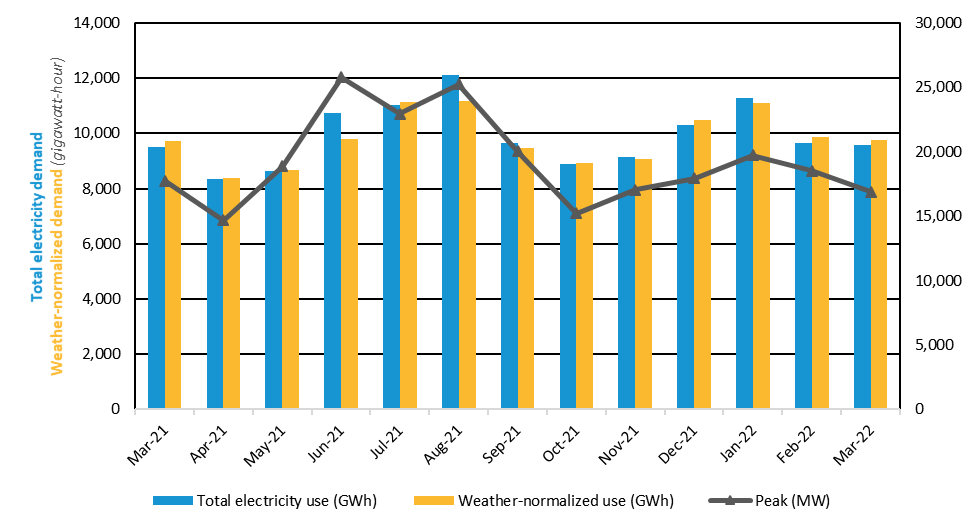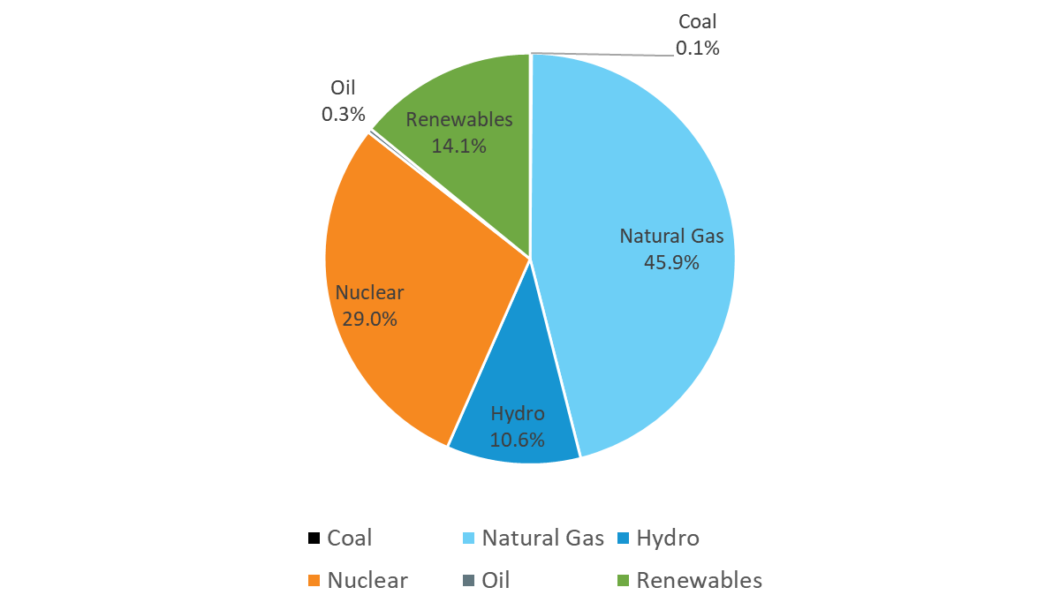Monthly wholesale electricity prices and demand in New England, March 2022
Wholesale power prices averaged $66.32 per megawatt-hour (MWh)1 in the Real-Time Energy Market in March 2022, up 97% compared to the previous year. Day-Ahead Energy Market averages rose to $66.18/MWh, an increase of 90% from March 2021.
By the numbers
| March 2022 and Percent Change from March 2021 and February 2022 | March 2022 | March 2021 | February 2022 |
| Average Real-Time Electricity Price ($/megawatt-hour) | $66.32 | 97.4% | -39.0% |
| Average Natural Gas Price ($/MMBtu) | $6.67 | 96.2% | -54.3% |
| Peak Demand | 16,905 MW | -4.8% | -8.8% |
| Total Electricity Use | 9,593 GWh | 1.0% | -0.5% |
| Weather-Normalized Use2 | 9,760 GWh | 0.4% | -0.9% |
Drivers of wholesale electricity prices
In general, the two main drivers of wholesale electricity prices in New England are the cost of fuel used to produce electricity and consumer demand.
Power plant fuel
Fuel is typically one of the major input costs in producing electricity. Natural gas is the predominant fuel in New England, used to generate 53% of the power produced in 2021 by New England’s power plants, and natural gas-fired power plants usually set the price of wholesale electricity in the region. As a result, average wholesale electricity prices are closely linked to natural gas prices.
The average natural gas price during March was $6.67 per million British thermal units (MMBtu)3. The price was up 96% from the March 2021 average Massachusetts natural gas index price of $3.40/MMBtu. The Mass. index price is a volume-weighted average of trades at four natural gas delivery points in Massachusetts, including two Algonquin points, the Tennessee Gas Pipeline, and the Dracut Interconnect.
March wholesale electricity and natural gas prices

Electricity demand
Demand is driven primarily by weather, as well as economic factors. Energy usage during March increased 1.0% to 9,593 GWh from the 9,500 GWh used in March 2021. The average temperature during March was 40˚ Fahrenheit (F) in New England, unchanged from the previous March. The average dewpoint, a measure of humidity, was 26˚F in March, up 4˚ from the previous March. There were 791 heating degree days4 (HDD) during March, while the normal number of HDD in March is 882 in New England. In March 2021, there were 771 HDD. There were no cooling degree daysin March.
Consumer demand for electricity for the month peaked on March 1 during the hour from 6 to 7 p.m., when the temperature in New England was 36°F and the dewpoint was 29°. Demand reached 16,905 MW. The March 2022 peak was 4.8% lower than the March 2021 peak of 17,767 MW, set during the hour from 6 to 7 p.m. on March 2, when the temperature was 24°F and the dewpoint was -4°.
Peak demand is driven by weather, which drives the use of heating and air conditioning equipment. The all-time high winter peak was 22,818 MW, recorded during a cold snap in January 2004 when the temperature was -1°F and the dewpoint was -20°. The all-time peak demand in New England was 28,130 MW, recorded during an August 2006 heat wave, when the temperature was 94°F and the dewpoint was 74°. Air conditioning use is far more widespread than electric heating in New England, so weather tends to have a relatively greater impact on the summer peak than the winter peak.
March monthly peak demand and total and weather-normalized energy use

Fuel mix and emissions
The mix of resources used in any given time period depends on price and availability, as well as supplemental resource commitments needed to ensure system stability. Natural gas-fired and nuclear generation produced about 75% of the 8,583 GWh of electric energy generated within New England during March, at about 46% and 29%, respectively. Renewable resources generated about 14% of the energy produced within New England, including 5.5% from wood, refuse, and landfill gas; 5% from wind; and 3.4% from solar resources. Coal resources generated 0.1% while oil-fired resources generated 0.3%. Hydroelectric resources generated 10.6%. The region also received net imports of about 1,166 GWh of electricity from neighboring regions.
March generation in New England, by fuel source

The mix of resources used to produce the region’s electricity is a key driver of CO2 emissions. The ISO estimates these emissions through an analysis that blends data on electricity generation by fuel type with an emissions factor for each fuel that is based on data from the Environmental Protection Agency.
March estimated CO2 emissions in New England, by fuel source (metric tons)

New England power plants produced an estimated 2.295 million metric tons of CO2 in March 2022, up 3% from 2.227 million metric tons in March 2021. Emissions were down about 8% from the estimate of 2.508 million metric tons in February 2022.
Estimated CO2 emissions from natural gas-fired plants—typically the largest source of emissions, due to the significant amount of power these resources produce—increased about 10% year over year, from 1.437 million metric tons to 1.583 million metric tons.
Estimated CO2 emissions from oil-fired resources saw the largest year-over-year increase. At an estimated 47,066 metric tons, the March 2022 figure is nearly 18 times the estimate of 2,672 metric tons in March 2021. Generation from oil-fired plants tends to increase when natural gas prices are high, because the wholesale markets select the lowest-priced resources to produce the electricity needed to meet consumer demand. With natural gas prices nearly twice as high this year as in March 2021, oil-fired generation in March 2022 totaled 28,285 MWh, compared to less than 2,000 MWh last year.
Estimated emissions from coal-fired plants saw the largest decrease for the month, falling 79% year over year. The drop, from an estimated 56,347 metric tons to 11,563 metric tons, reflects the retirement of a coal-fired unit in June 2021. At 10,474 MWh, the amount of power coal-fired resources produced in March 2022 was significantly less than the 51,039 MWh generated last March.
CO2 emissions from other resources—mostly refuse and wood—were estimated at 653,741 metric tons in March 2022, down 11% from 730,947 metric tons last year.
1One megawatt (MW) of electricity can serve about 750 to 1,000 average homes in New England. A megawatt-hour (MWh) of electricity can serve about 1,000 homes for one hour. One gigawatt-hour (GWh) can serve about 1 million homes for one hour.
2Weather-normalized demand indicates how much electricity would have been consumed if the weather had been the same as the average weather over the last 20 years.
3A British thermal unit (Btu) is used to describe the heat value of fuels, providing a uniform standard for comparing different fuels. One million British thermal units are shown as MMBtu.
4A degree day is a measure of heating or cooling. A zero degree day occurs when no heating or cooling is required; as temperatures drop, more heating days are recorded; when temperatures rise, more cooling days are recorded. The base point for measuring degree days is 65 degrees. Each degree of a day’s mean temperature that is above 65 degrees is counted as one cooling degree day, while each degree of a day’s mean temperature that is below 65 degrees is counted as one heating degree day. A day’s mean temperature of 90 degrees equals 25 cooling degree days, while a day’s mean temperature of 45 degrees equals 20 heating degree days.

Historical weather data provided by DTN, LLC.; Underlying natural gas data furnished by ICE.
- Categories
- Inside ISO New England
- Tags
- monthly prices, wholesale markets
